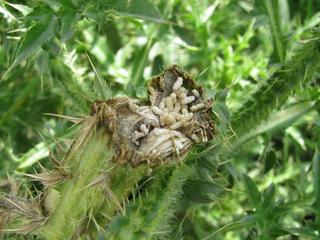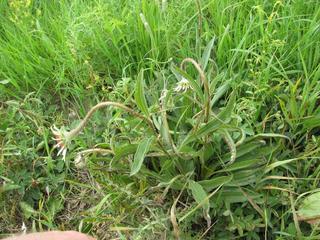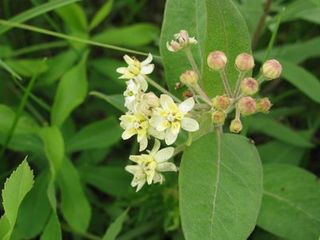|
|
Broken up from the previous entry so as to not make things too messy in the Stipa category.

Carduus out at KJ’s

Some critter snipped the stalk and laid some eggs, looks like.

This sad-looking Echinacea was out at NW of Landfill, along with other bent over and crummy-looking Carduus and others. The grasses and legumes around it looked pretty OK, so I’m wondering if perhaps these were hit by some herbicide overspray earlier in the season before the grasses grew up around it.
Stipa collection is going pretty well, aside from the Topcon being flaky and not connecting to the data network for improved accuracy (it should be good enough for refinding tags along with the metal detector). We’ve collected from 85 out of the desired 300 so far, with different averages of seeds collected depending on the site. Landfill and Staffenson both had rather high averages, somewhere around 9 or 10 (no math here, just guessing based on what I was entering in the data fields) while some of the scattered remnants were closer to 5 or 6.
As for today, I’ll be out with someone to go search at other sites, hopefully, but the weather is looking a bit questionable today. We’ll see!
This afternoon I spent some time with Terrasync, getting a data dictionary together for Hesperostipa seed collection. What does this mean?
This means I can take the GPS out, throw down a tag, collect some seed, then, while taking GPS points, put the various bits of information about the seed that I want directly into the Trimble. Geospatially referenced data with little effort!
Making sure that the GPS Pathfinder Office’s transfer utility is pointed at the right device (GPS Logger on Windows CE, in this case), you click “Send”, “Add” a data dictionary and browse to the file and Transfer All. You did create your data dictionary, right? No?
Well, take a step back and click on Data Dictionary Editor in the Utilities menu. From here, it’s pretty straightforward to create your very own data dictionary. Add the Features you want (features being the kinds of points you want. I added one for Stipa individual). From there, you add Attributes. These are the fields you want to take data on: whatever would be on your paper data sheet. Annoyingly, text fields are limited to a mere 100 characters, so keep that in mind for your comments fields (always have one; you never know!). Useful ones for me were Numeric (tip! if you want to widen the number entry field from the measly default of 2 characters wide, put some large number as your maximum value; you won’t be able to go above that, but that’s not a problem for my tag and envelope number fields. Certainly nothing will be above 1000000), Text, and Date. After getting your dictionary squared away, save it somewhere and transfer it to the Trimble.
At this point you should take the new data dictionary for a test run. Restart the Terrasync software on the Trimble and start anew. Create a new file and start taking a point. See if the dictionary suits your needs. If not, go back, fix your dictionary and retransfer, overwriting the old one. Now you’re collecting with style!
For the collection dictionary, I selected the following fields:
Tag Number (text)
Envelope Number (text)
# Seeds Collected (numeric)
Location (text)
Notes (text)
Notes2 (text; text is limited to 100 characters which may not be quite enough)
Current Date (date; autogenerated)
Collected By (text)

I’m back! You may have noticed all my photo links are broken… well, that website is dead and I can’t edit my old posts. I’ll go back through and comment on my posts with pictures with updated links so you can have a clue as to what’s going on.
I now keep a (nearly) daily photo blog on Blipfoto and will do weekly posts linking all of the photos from that week, along with other photos and posts as necessary.
As for my project this season, I’m interested in looking at the effects of humidity on the awns of Hesperostipa spartea (aka Stipa spartea. thanks, plant geneticists). The current idea is to construct some sort of variable-humidity chamber with a humidity guage readable by time-lapse photography. I expect this will involve a sealed chamber and a humidifier, dehumidifier, and some way to control them powering on and off. The seeds will be in the chamber, digging through artificial duff or maybe just looking at how the awns curl.
How are we figuring out what goes where? In most KAP applications, the camera is pointed at the horizon, or slightly towards the ground from the horizon. It’s pretty easy to get landmarks this way (trees, buildings, roads, stuff like that). Looking at the ground, however, it’s not so easy. How do you get good landmarks in a sea of green?
Simple. Ground markers.

It’s really a pretty simple marker. Made from 2 pieces of meter-long wood (it’s several centimeters wide, but I don’t recall off the top of my head.) The boards are painted a flat white, North is painted red (lighter grey in the above image). The stripes are painted flat black (darker grey in the image). The boards are drilled through the center and affixed with a bolt and wing nut, to easily collapse them for storage and transport. Red is painted on the edge of the east-west board facing north, to keep it keyed when unfolding.
Download a PDF with 20 ground markers already made
Download the GIMP source file for the ground markers
Now that I’ve gotten a new toy, I’ve gotten several more pictures. Not all of them are with this fun lens though.

Let’s start with the sex. Tittilating thorn hoppers! Mating monarchs! Lusty Lepidopterans!
Then there are the critters I don’t recognize. This looks to me like some beetle larva (but I really have no idea). Shiny beetle on some thistle.
Jameson has just informed me that these are thorn hopper larva. Around the Andes Tower property, we came across a spider having a meal of a dragonfly. Don’t forget tiger beetles.
As for our plant portaits, I’ve got some Asclepias speciosa, showy milkweed. Allium has some pretty neat flowers. Like Earl Grey tea? Then you’ve had some of the tasty wild bergamot, Monarda fistulosa. The common garden has quite a bit of Solidago rigida, or stiff goldenrod.
Here’s a rundown of our equipment and various settings that we’re using.
Kites:
Sutton Flowform 16
G-kites Dopero
Peter Lynn Pilot 50
Other kite bits:
Horizontal Brooxes AutoKAP Kit
A plastic winding halo
200 and 250 lb test string
Cameras and accessories:
Canon S70
Canon EOS 400D / Digital Rebel XTi
Canon 50mm f/1.8 prime lens, aka the Nifty Fifty
GentLED infrared LEDs for setting off the camera by remote
Tower Hobbies RC FM transmitter and receiver
Software:
the GIMP (Free image manipulation)
UFRAW (includes a GIMP plugin for reading RAW images)
General camera settings:
Manual focus, set to infinity
Tv mode (shutter priority) set to 1/800 or 1/1000
RAW mode (RAW+640×480 on the S70, RAW on the XTi)
ISO 100 (200 or 400 if it’s not sunny, though noise can sneak in at ISO higher than 400)
Bracketed down 1/3 stop
Zoomed out as much as possible (50mm on the XTi [doesn’t zoom anyway, as it’s a prime lens), ~28mm on the S70)
Remote-driven mode
Other bits:
Wooden ground markers (details soon, including images)
Paint
It was Friday the 13th, the kind of day the superstitious worry about and the kind that I figure is just another day. The wind was pretty good, enough to pick up our Flowform 16 kite with our camera rig. We went out to North by Northwest of Landfill and set out our ground markers [images when our internet gets back up]. With a pretty good wind from the west, we got the kite up and the camera rig above the roadside population. We took two runs along the road, once south and once north (higher and lower). Overall, it was a good run.
Until…
Until we plugged the camera into the computer. No images. Hrm.
We were using a new setup that day. Stuart had bought a radio-control set that we hooked up to the camera. It seemed to work just fine at the farmhouse… but not at the site. At this point, Julie and I were painting the kite string (so we could tell how much line was let out). Testing the RC stuff again, it SHOULD have worked fine. We’re not sure why it didn’t.
Cut to the next day. We left the string out to dry when we left in the evening and between our departure and Stuart’s taking the line in a few hours later, some cheeky rodent decided that our artificial string would be a tasty snack and gnawed through it in a few places. Friday the 13th strikes again.
And now today. The 200-lb test line has been painted and is currently drying. I’ve worked out one of the problems with our camera rig (before, the camera would take a picture all the time: all that was needed was putting it on a different control stick. [images for clarity later]). I can now control both the Canon S70 and the new Canon Digital Rebel XTi (with The Nifty Fifty, a 50mm prime lens. It’s a touch long, but our benefit in megapixels and in general quality should be worth it) with the press of a control stick.

The toilet has again been modified. With the addition of the spider plant, the toilet is no longer a seat. It was uncomfortable anyway. The “maximum loading…” sticker came from the $10 hammock I bought from a garage sale. Not sure where to put it, but the trees near the pond seem to be the best bet. All I need is something to attach to the trees to attach to the hammock’s chains.
Jameson has barricaded his garden in an effort to keep the enemy at bay. The enemy includes the likes of deer, bunnies, and probably ground squirrels.
Colin shot off some “fireworks” last night. A few of the pictures turned out well.
Overall, today went pretty well. We managed to get the camera up on the small kite. 
The wind gave us a few problems, though. The camera came down a few times and we had to run to grab it. 
The big kite, however, had issues. After letting it out around 80 meters, the kite took a dive to the right… into a building. WHAM. This isn’t a sound you want to hear. A few tears on the front, but not horrible. The problem came when Stuart was moving the kite. A gust of wind caught the kite around him. SNAP. Another bad sound. The carbon-fiber sticks were fine; an aluminum connector was not.
|
|







